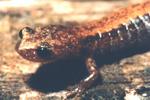
The effect of artificial night lighting on nocturnal emergence and activity in the red-backed salamander, Plethodon cinereus.
Researchers: Jasmina Samardzic (project lead, Junior ), Dain Heath (senior), Daniel Long (senior), Jennifer Liu (Freshman), Kayla Paratore (Freshman), Sharon Wise and Bryant Buchanan. 2015- present.
Red-backed salamanders, a common inhabitant of Northeastern Deciduous Forests are only active above ground at night. Salamanders typically forage for insects and engage in social interactions only at illuminations below 0.01 lx, about full moonlight. Artificial light at night increases above-ground illumination and has the potential to disrupt the nocturnal activity of animals, like salamanders, that are only active at night. In special chambers, we are exposing salamanders to a variety of different nocturnal illuminations (0.0001 lx, 0.01 lx, 1 lx, and 100 lx) ranging from natural darkness to room lighting. We are recording the nocturnal and diurnal movements of salamanders in each treatment and then using digital image tracking software to evaluate how much salamanders move and when they move under each of the different night lighting conditions.



